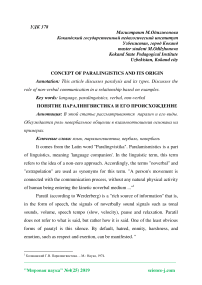Concept of paralingistics and its origin
Автор: Odilzhonova M.
Журнал: Мировая наука @science-j
Рубрика: Основной раздел
Статья в выпуске: 4 (25), 2019 года.
Бесплатный доступ
This article discusses paralysis and its types. Discusses the role of non-verbal communication in a relationship based on examples.
Language, paralinguistics, verbal, nonverbal
Короткий адрес: https://sciup.org/140264499
IDR: 140264499
Текст научной статьи Concept of paralingistics and its origin
It comes from the Latin word "Paralingvistika". Paralamismistics is a part of linguistics, meaning 'language companion'. In the linguistic term, this term refers to the idea of a non-zero approach. Accordingly, the terms "noverbal" and "extrapolation" are used as synonyms for this term. "A person's movement is connected with the communication process, without any natural physical activity of human being entering the kinetic noverbal medium ..."1
Paratil (according to Werderberg) is a "rich source of information" that is, in the form of speech, the signals of noverbally sound signals such as tonal sounds, volume, speech tempo (slow, velocity), pause and relaxation. Paratil does not refer to what is said, but rather how it is said. One of the least obvious forms of paratyl is this silence. By default, hatred, enmity, harshness, and emotion, such as respect and exertion, can be manifested. "
Russian psychologist V.A. Labunskaya distinguishes her from the communicative act in the "NeverBalnoe Povedenie" series of diverse, types, components and elements. According to him, the noverbal vehicles are first subdivided into such categories as extorting, propagation, cinema, and boots. The categories, in turn, are varieties such as extralinguistics - pausing, coughing, sighing, laughing, and weeping; prosody - types such as pronunciation, sound, tempo, timbre; cinética - types such as erysipelas, erythematous movements, eyesight; The collar is divided into types such as static and dynamic collisions, which, in turn, are divided into components and elements.2
Generally speaking, the noverbal means have been linked to speech as an expression-enhancing technique. Until now, noverbal tools show the recipient's interior. That is, the outward appearance of the inner spiritual world of a person. In other words, noverbal tools can be considered as images of speech. Consequently, the proverbial motor is a social regulator of the speech, in addition to the speech that has been introduced in the dialogue. "Only 7% of people think that they want to talk in the conversation, while the other 38% hear the tone and 55% signify."The concept of paralamism was first introduced by the American linguist A. Xill in the late 1940s. However, in the 1930s, the Russian linguist NV Yushmanov was known to have used Extranormalnaya phonetics in his researches, which indicates that a parallelism was first started in the 1930s. At present, extensive extravagance is one of the newest and most up-to-date topics of linguistics, such as journalism, psycholinguistics, bioengineering, linguoculturology and introling.
While nonverbal means are used to communicate directly in the communication process and serve as an emotional outlook, expressive "life expectancy", there are actions that characterize the behavior of various professions, such as those without speech. These behaviors also provide specific meaning and meanings on their own. Thus, the Russian psychologist explains such actions as "never-ending pověstenie". Noverbal behavior specific to the characteristics of different professions can be evaluated as professional or social noverable behaviors. This creates a justifiable question whether it is possible to distinguish between the socialist actors and the public.
Paralymmology is becoming a research object for western and eastern psychologists, pedagogues, medical workers and linguists. It has always been a concern for a psychologist, sociologist, and linguist, and that they have been transformed into research objects, as human beings combine their speech with specific actions. Initially, psychologists called the proverbial tools "Expressive Acts" and studied them in the context of the emotional circle under the "Expressive Behaviors" section.
When entering the class teacher: He waits for the readers to stand up and say hello. In the course of the lesson, tapping the pens on the table to stop the noise triggers the "calm down", signaling the "stop" signals by tapping the display. The work of pedagogues requires the use of parallelism in daily activities and the ability to readily accept parallelism from students. The teacher tracks the pupils before they greet at the beginning, and calls for the preparation of silence and lessons through the body's movement and vision. In addition to verbal exercises, they teach and educate them through noverbal tools. For linguists, learning parallelisms helps to increase sensitivity in literary works, translate clarity. Thus, the societies in a particular social sphere use specific hierarchical actions to address their ideas and they have social character. Such a noverbal action can play a significant role in the behavior of my company and can be called professional actions. Indeed, it is not possible to ignore professional behavior in the study of communication behavior of different professions.
In addition to the above, it is worth noting that Paralingvistics, besides linguistics, is associated with such subjects as psychology, pedagogy, history, ethics, aesthetics, cultural studies, ethnography, anthropology, religion, speech culture, and allows us to understand and understand parallelism more efficiently . Studying psychology, history, ethnography, and anthropology of the origin of some of the paralympic means used in our everyday life is an object of their subjects, such as psychology, ethics, aesthetics, culturology, religion, and speech culture.
Список литературы Concept of paralingistics and its origin
- Колшанский Г.В. Паралингвистика. - М.: Наука, 1974.
- Лабунская В.А. Невербальное поведение. Ростов на Дону, 1986
- Митина Ю. Сущность паралингвистики. - Рязань 2010.
- Еникеев М.И. Общая и социальная психология - М.: Издательская группа Норма-Инфра. М,1999


